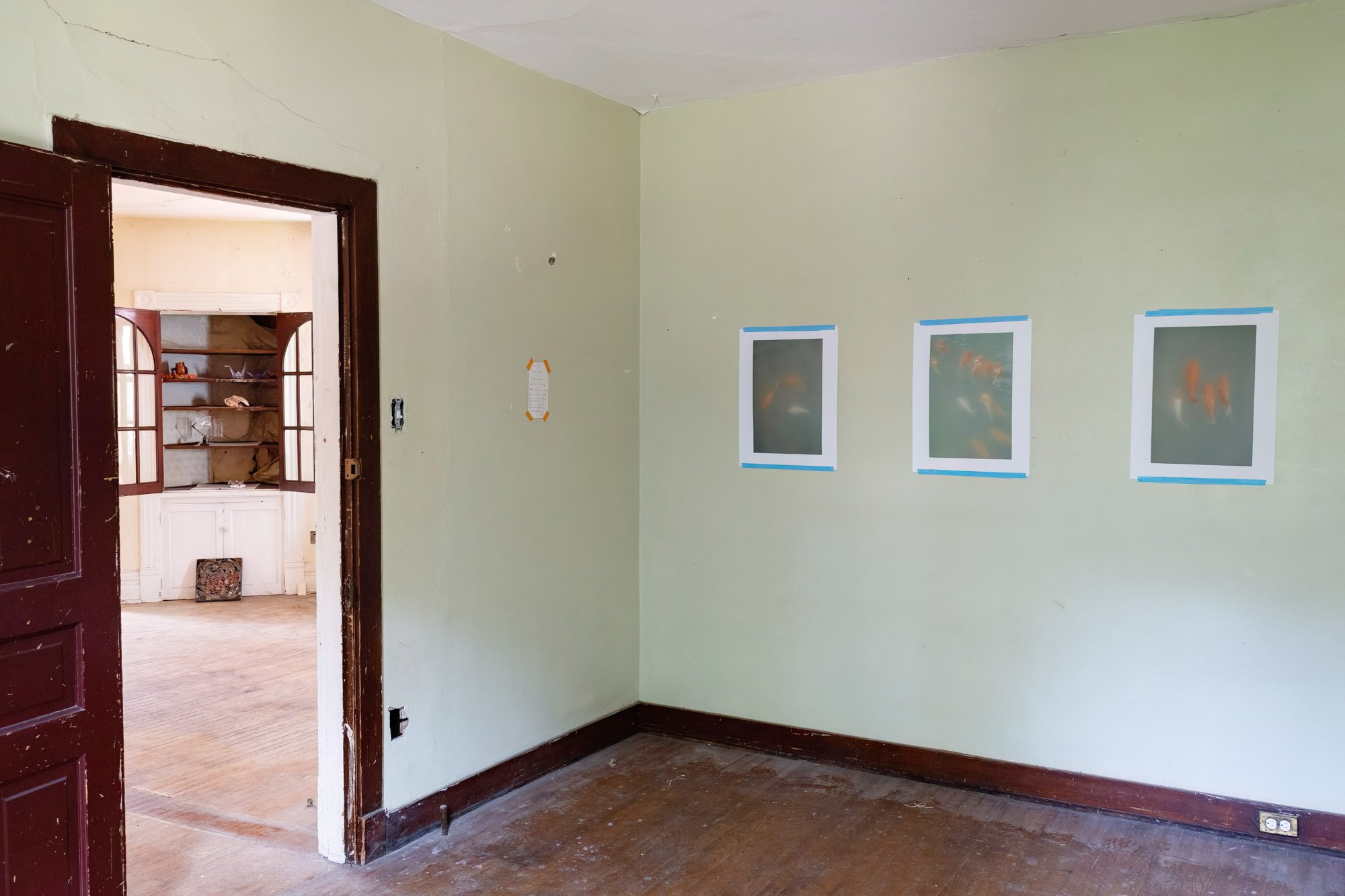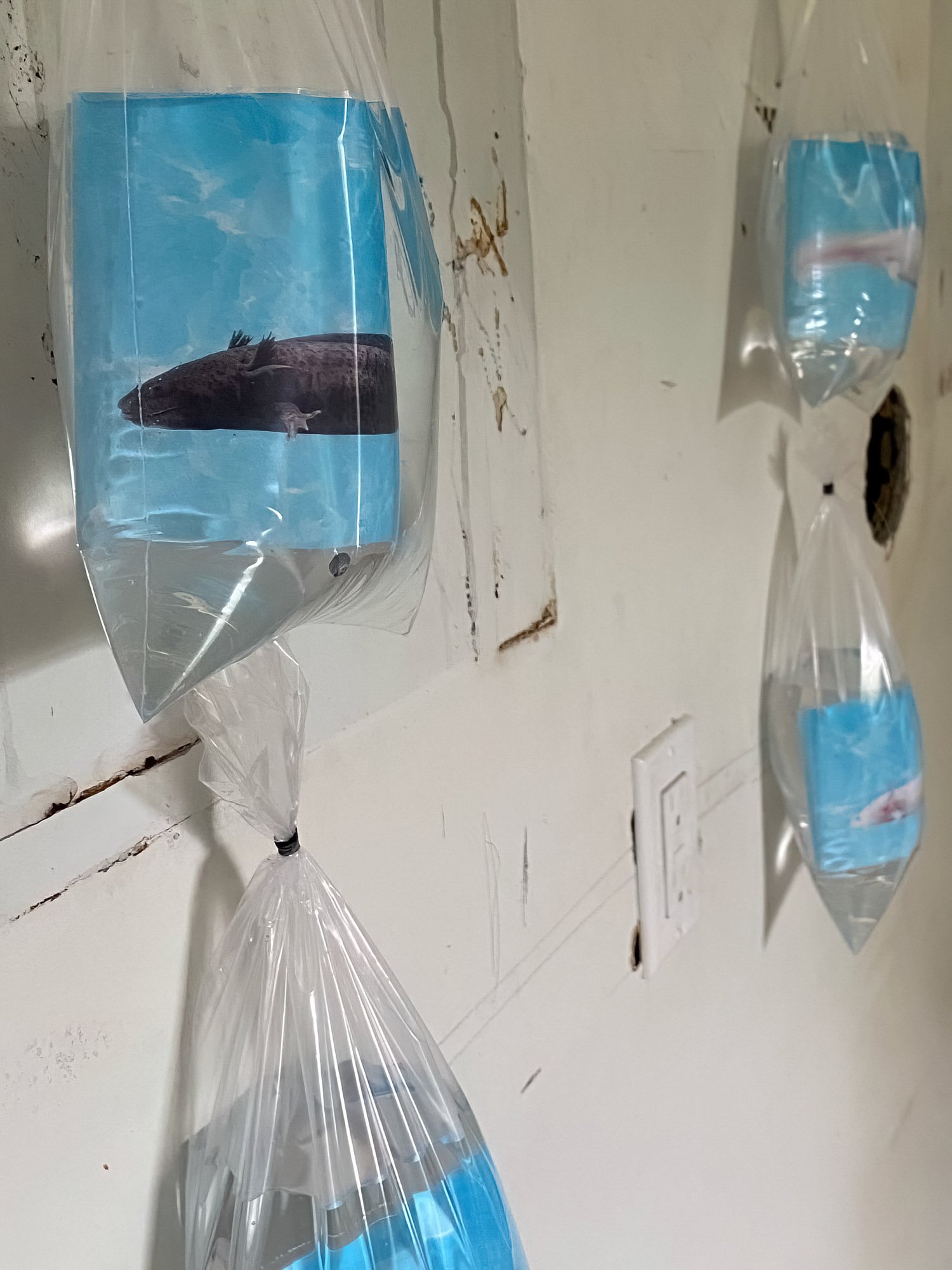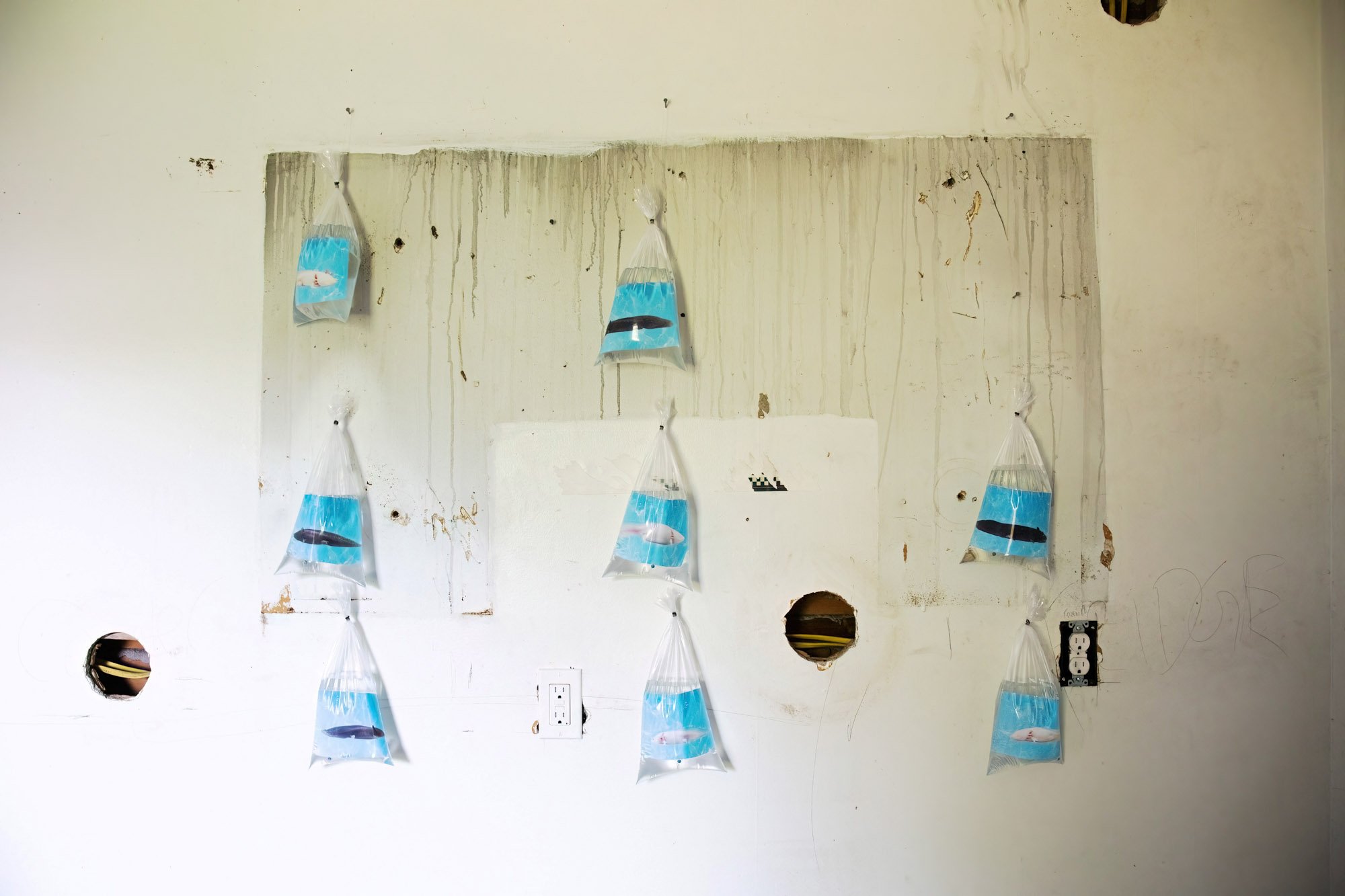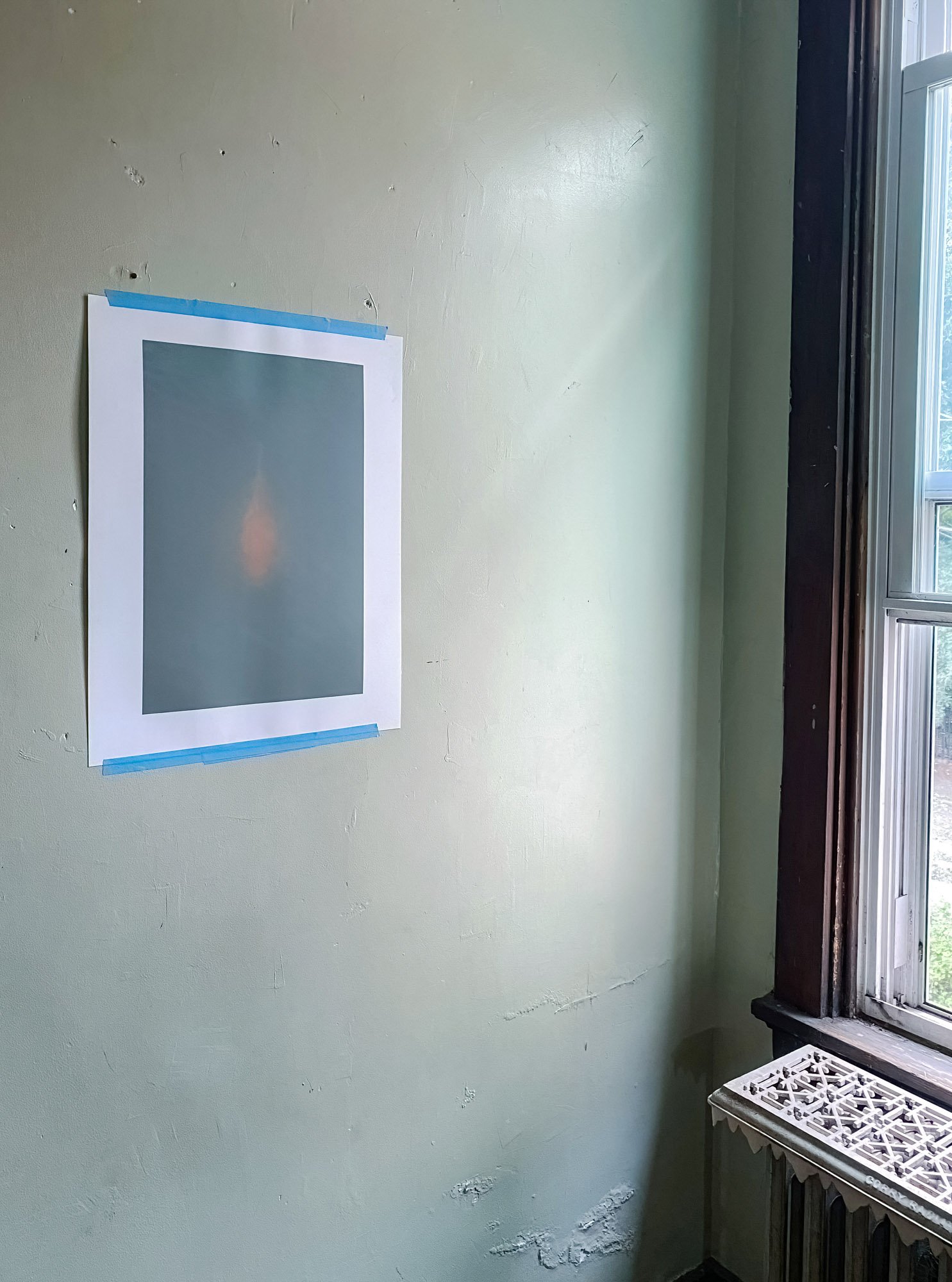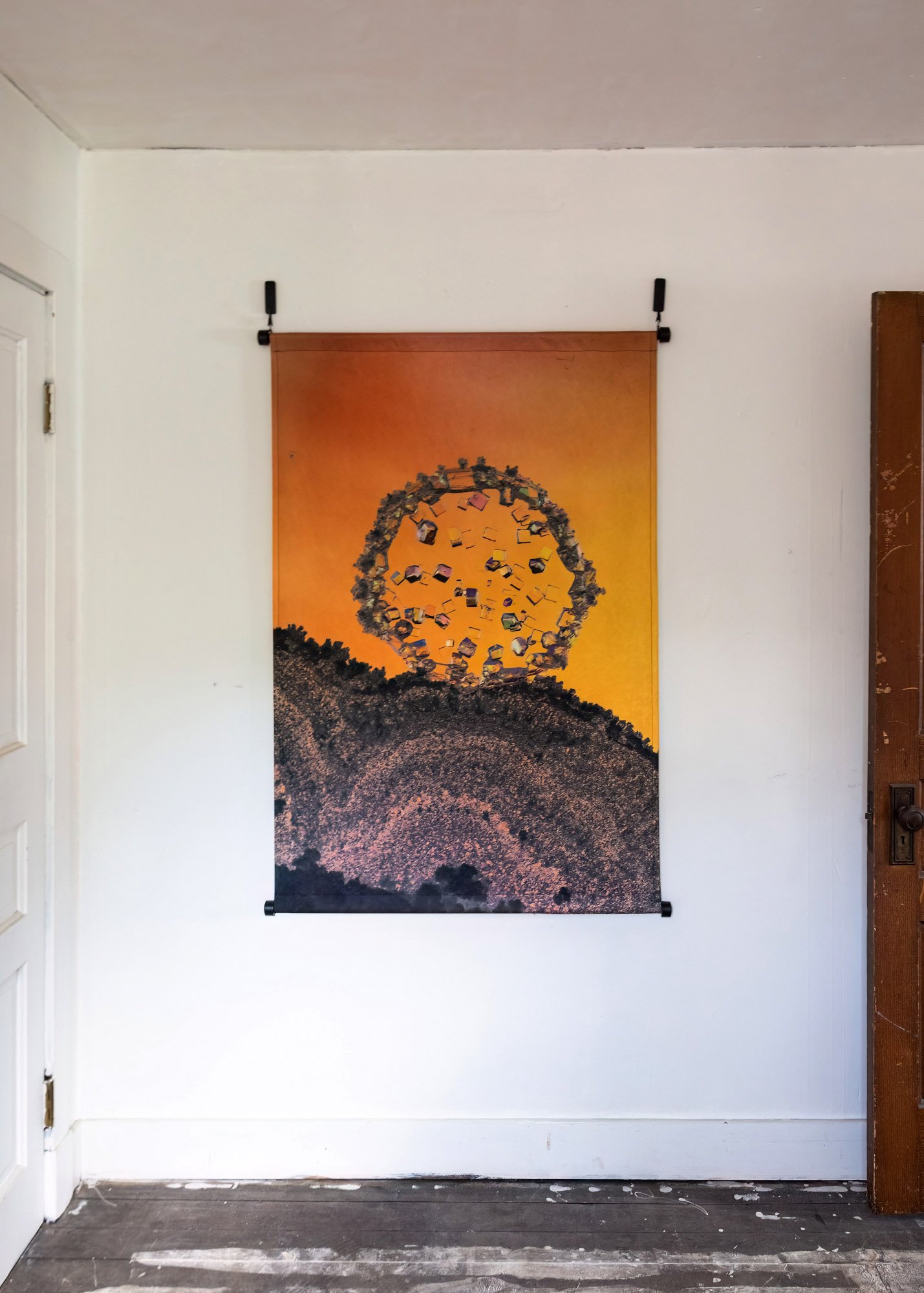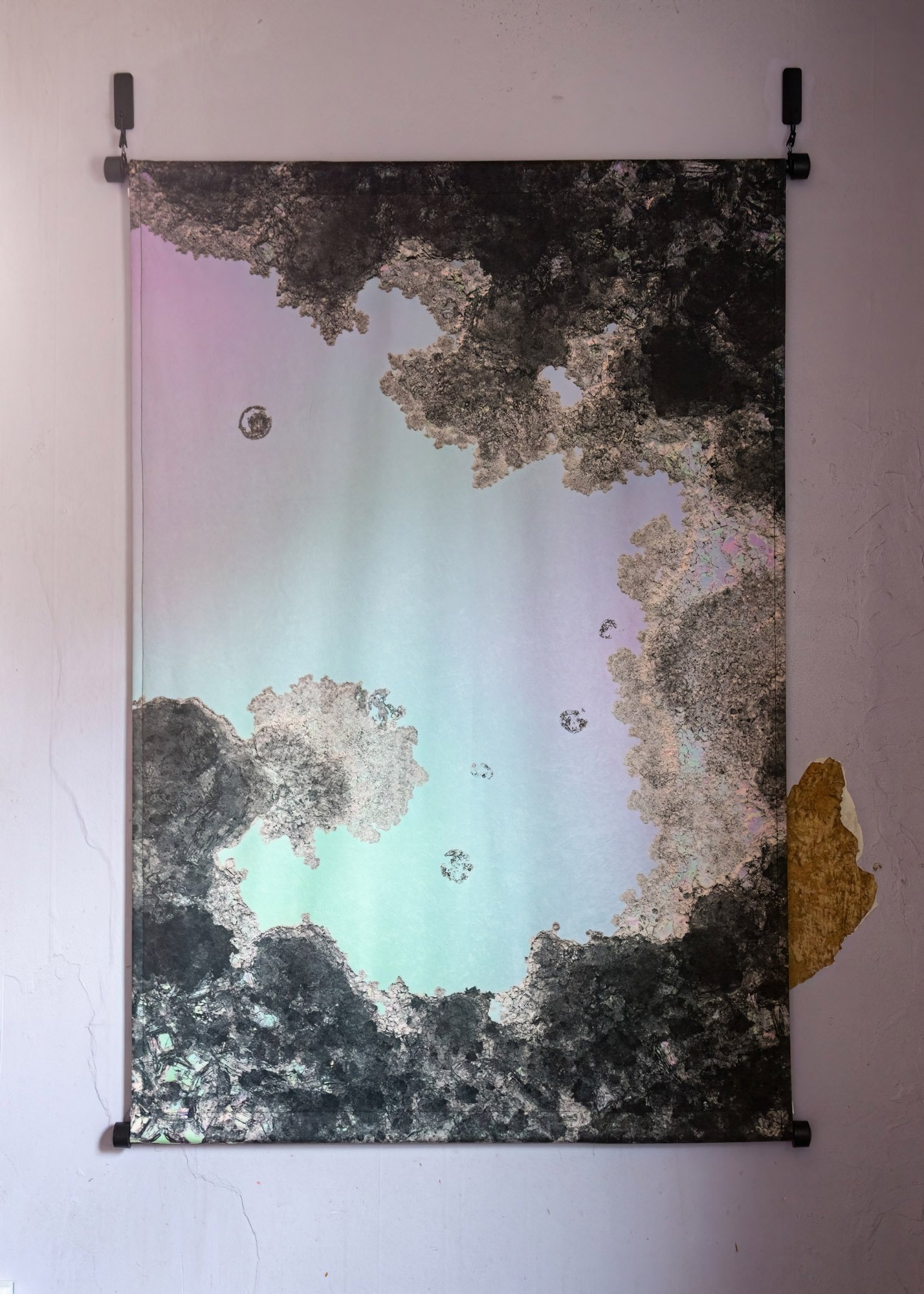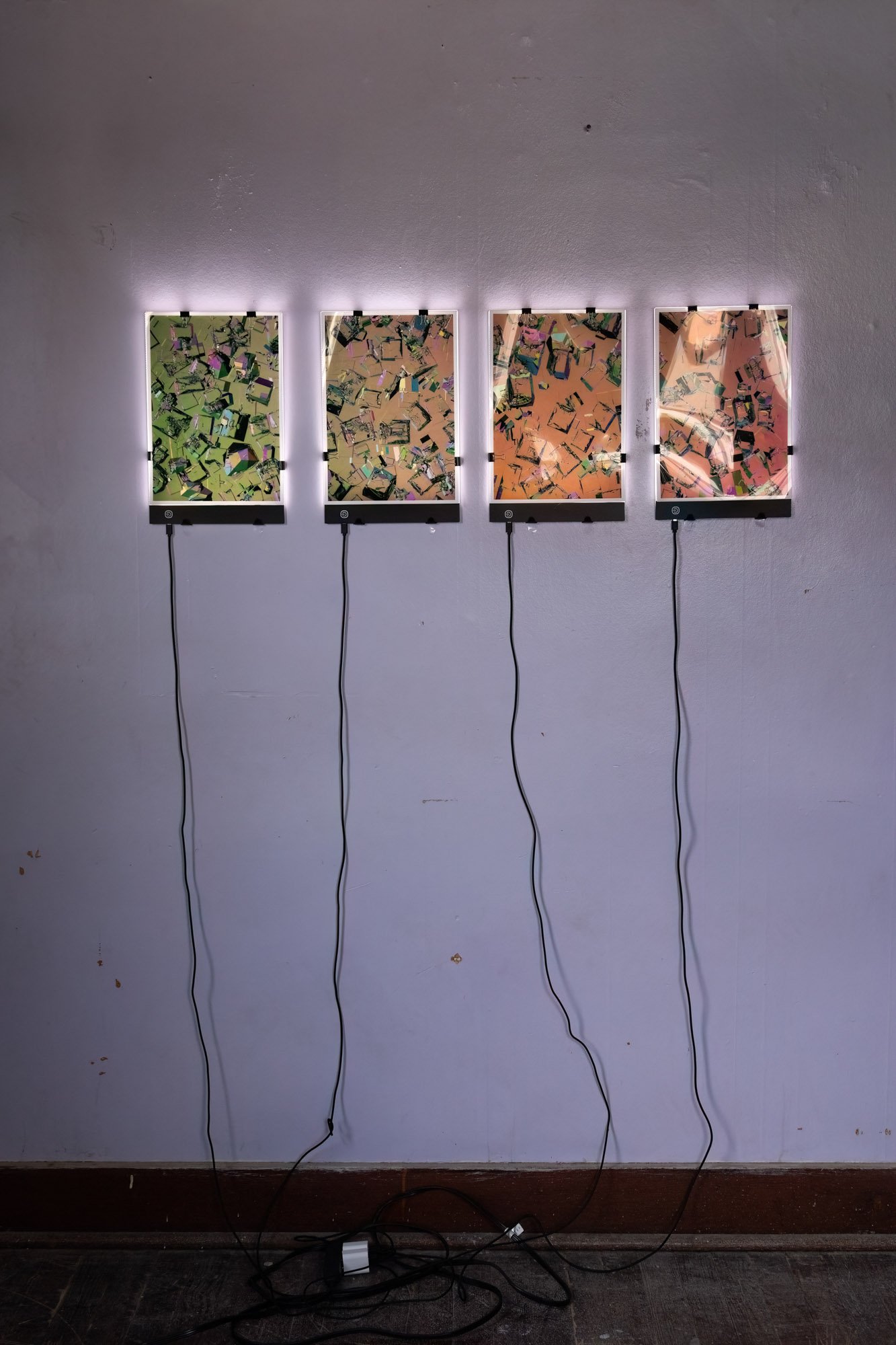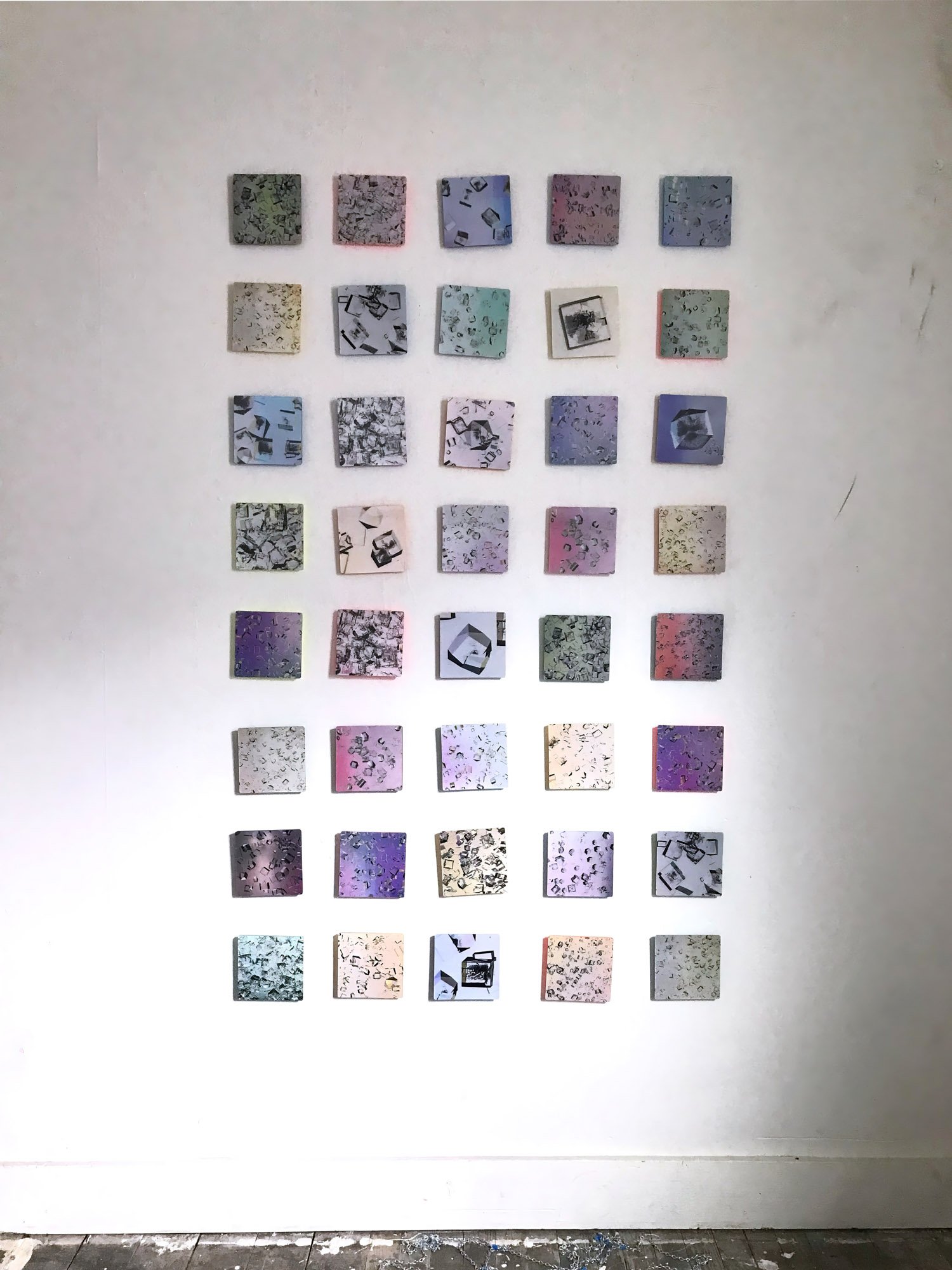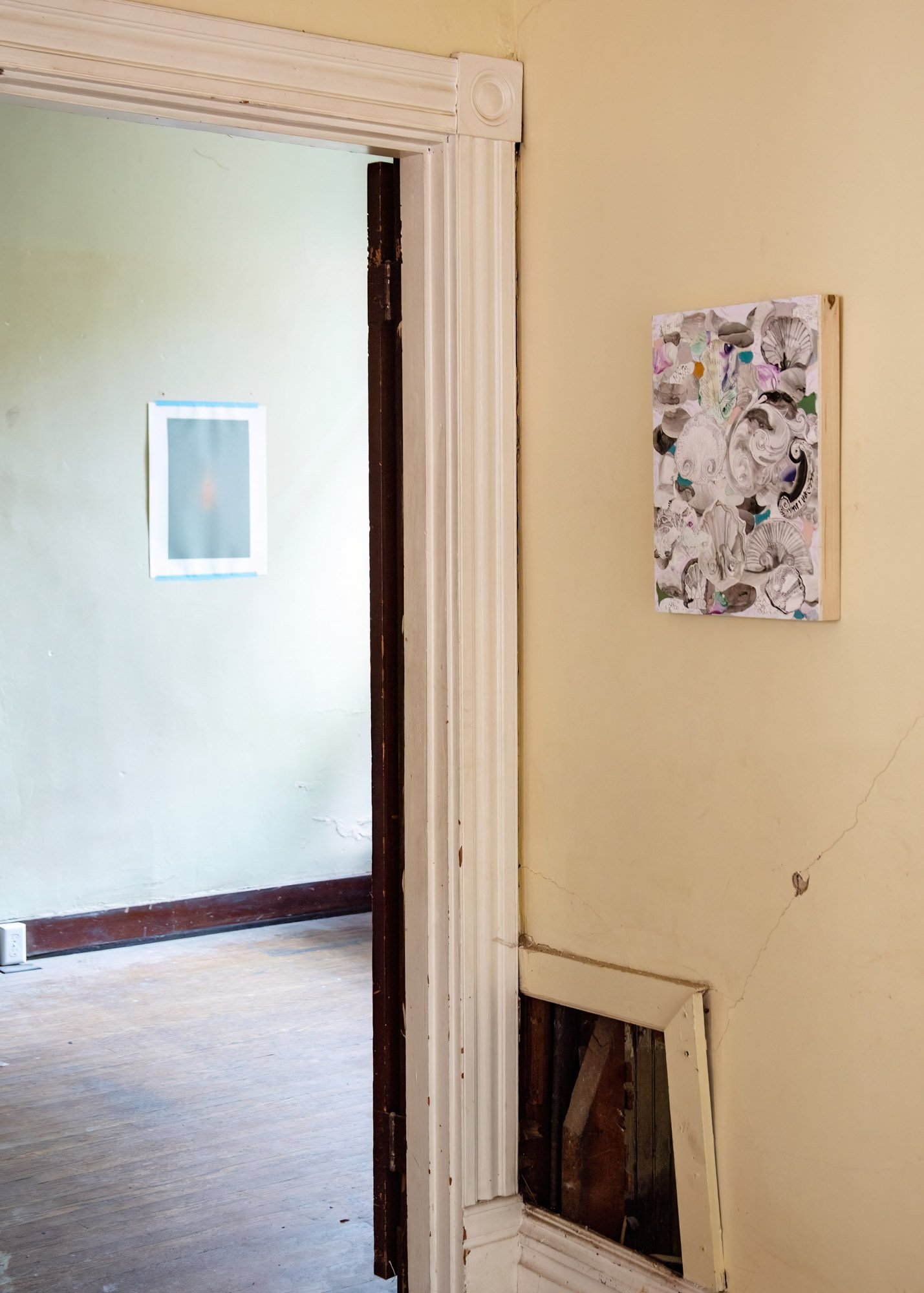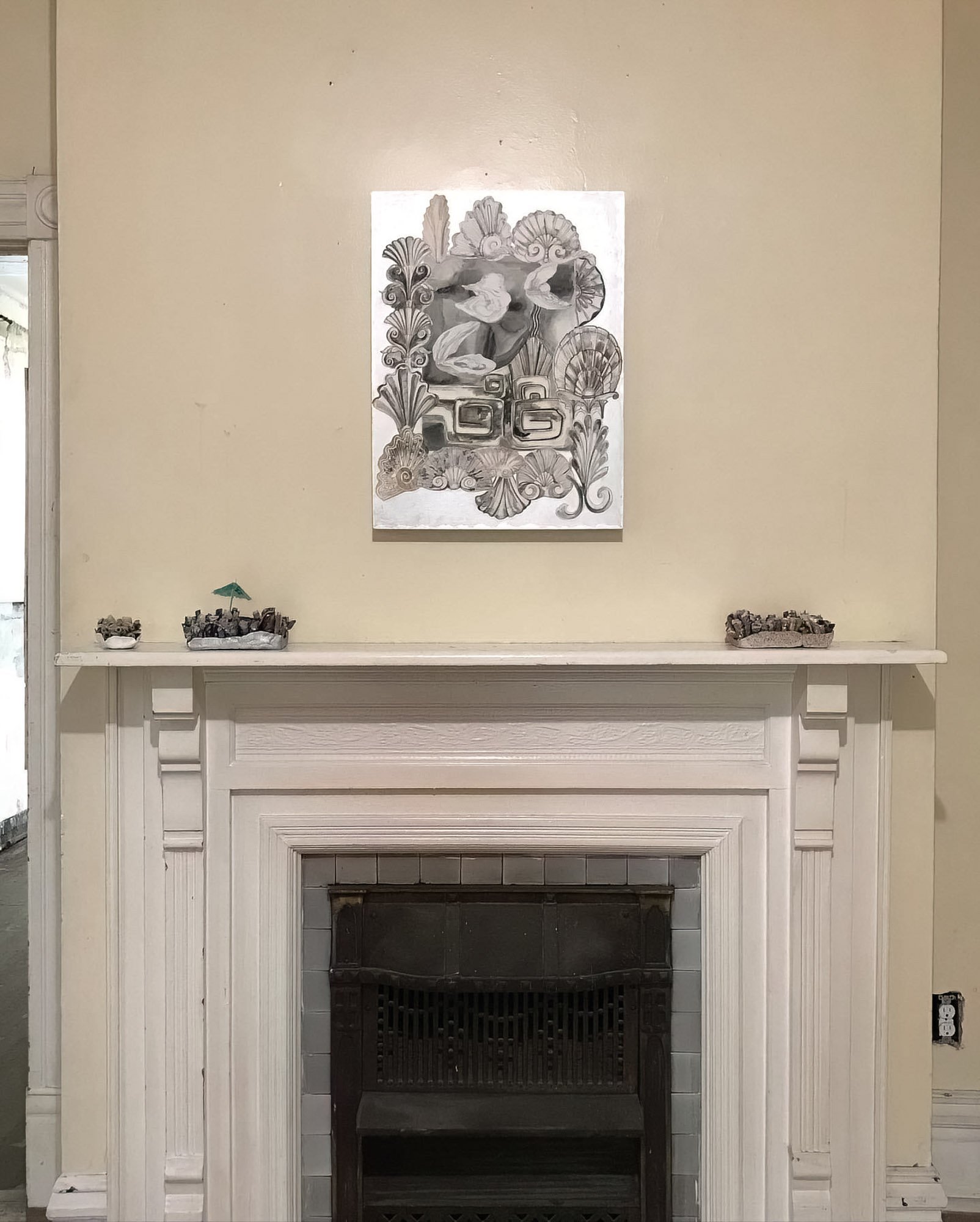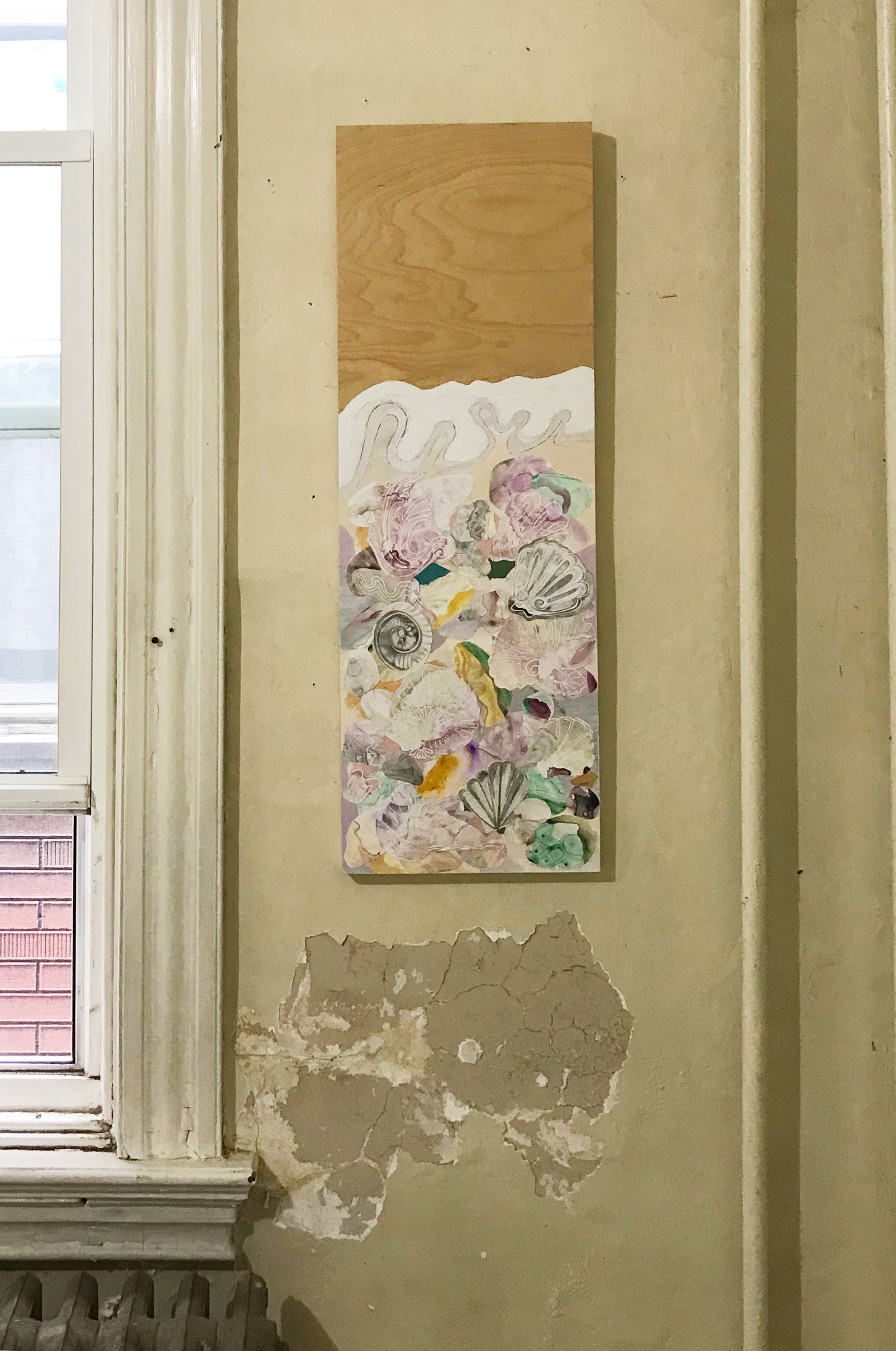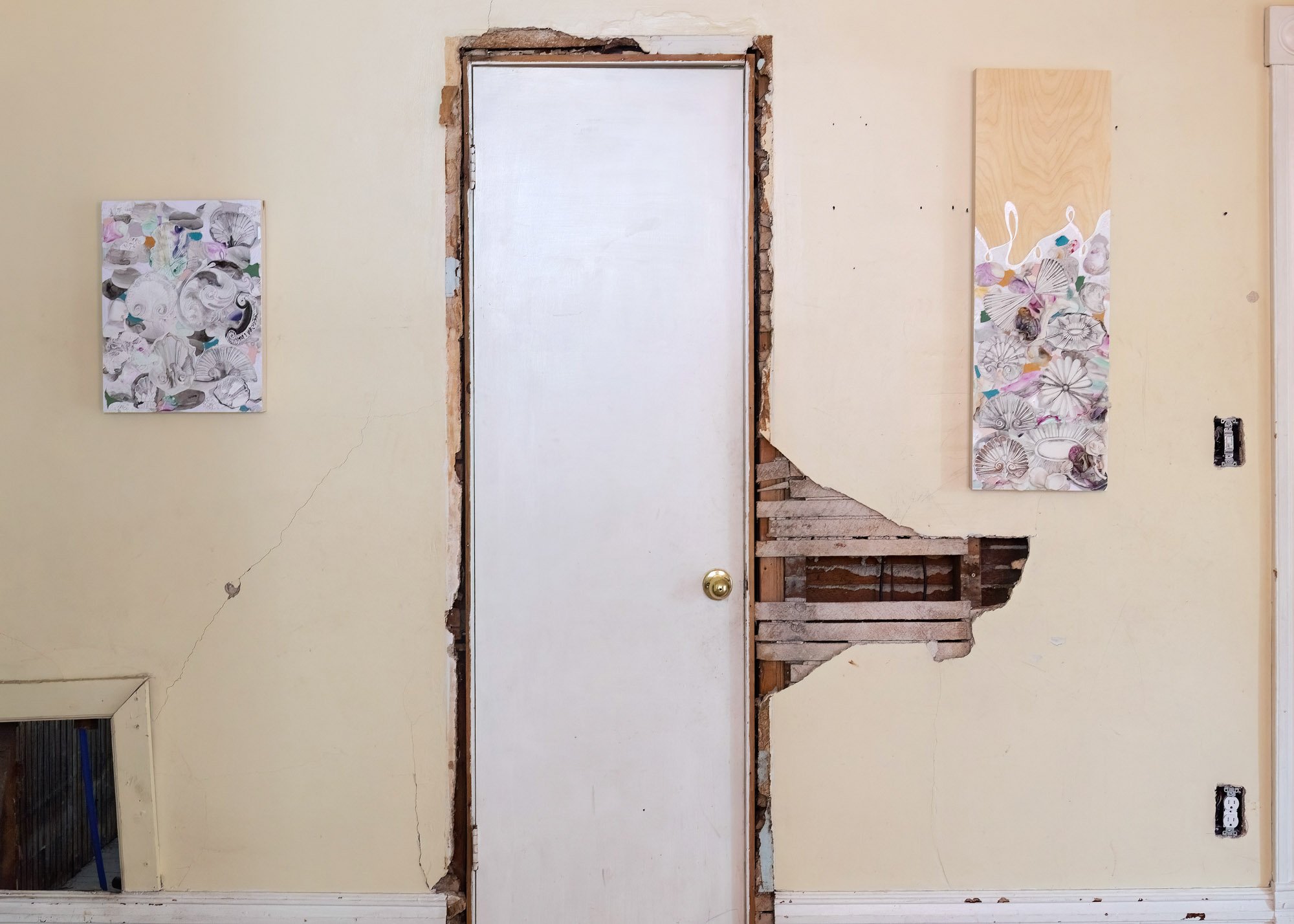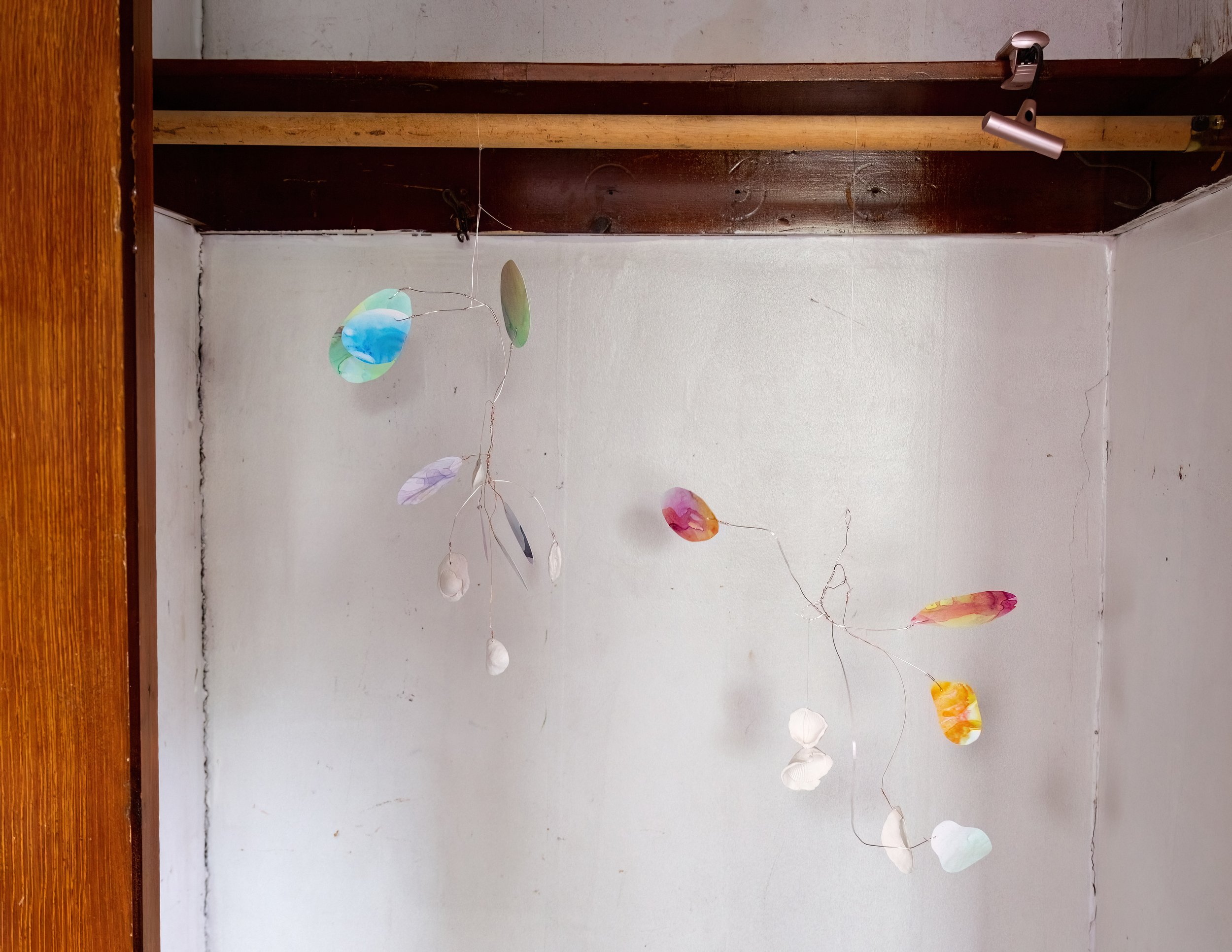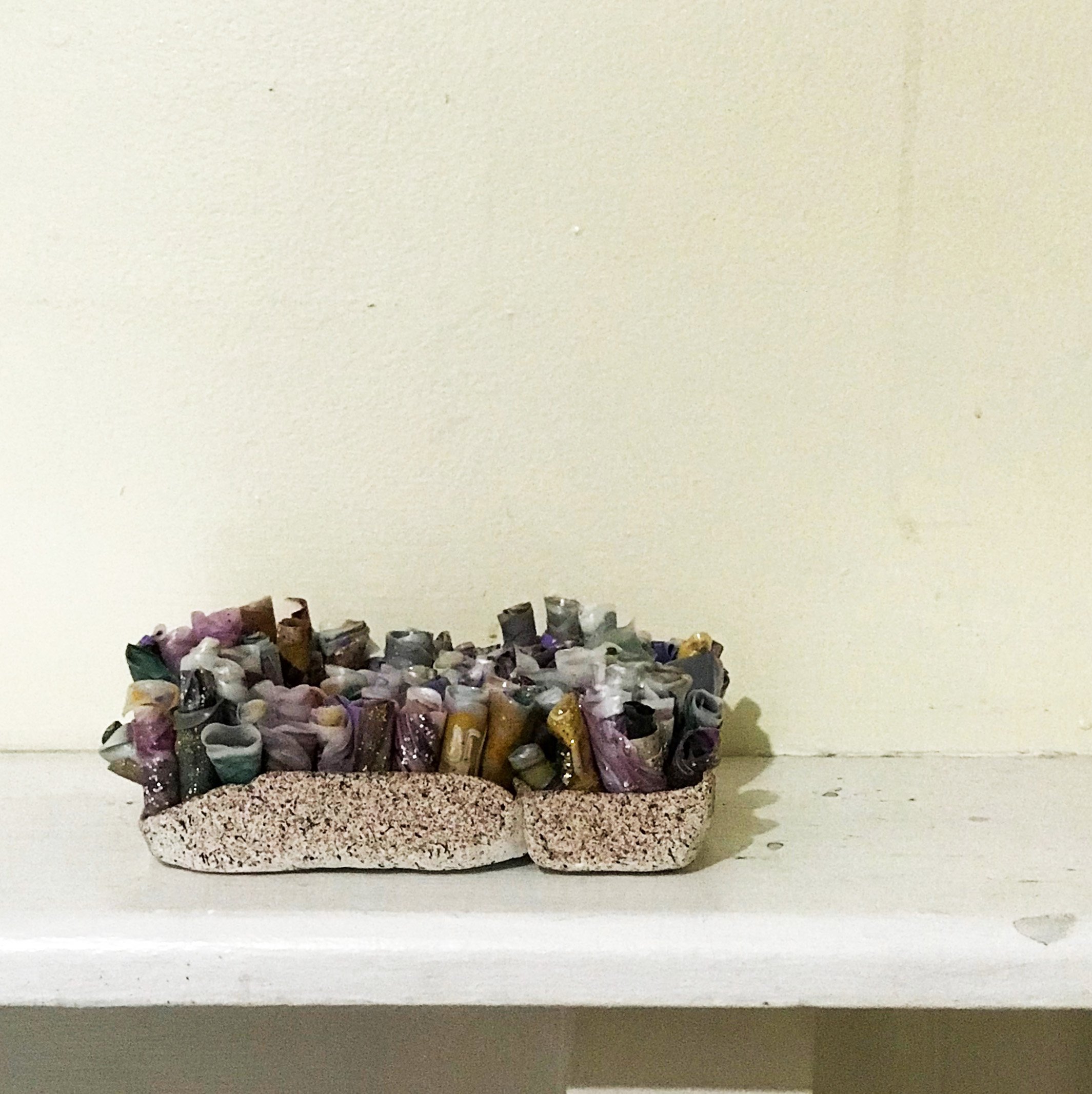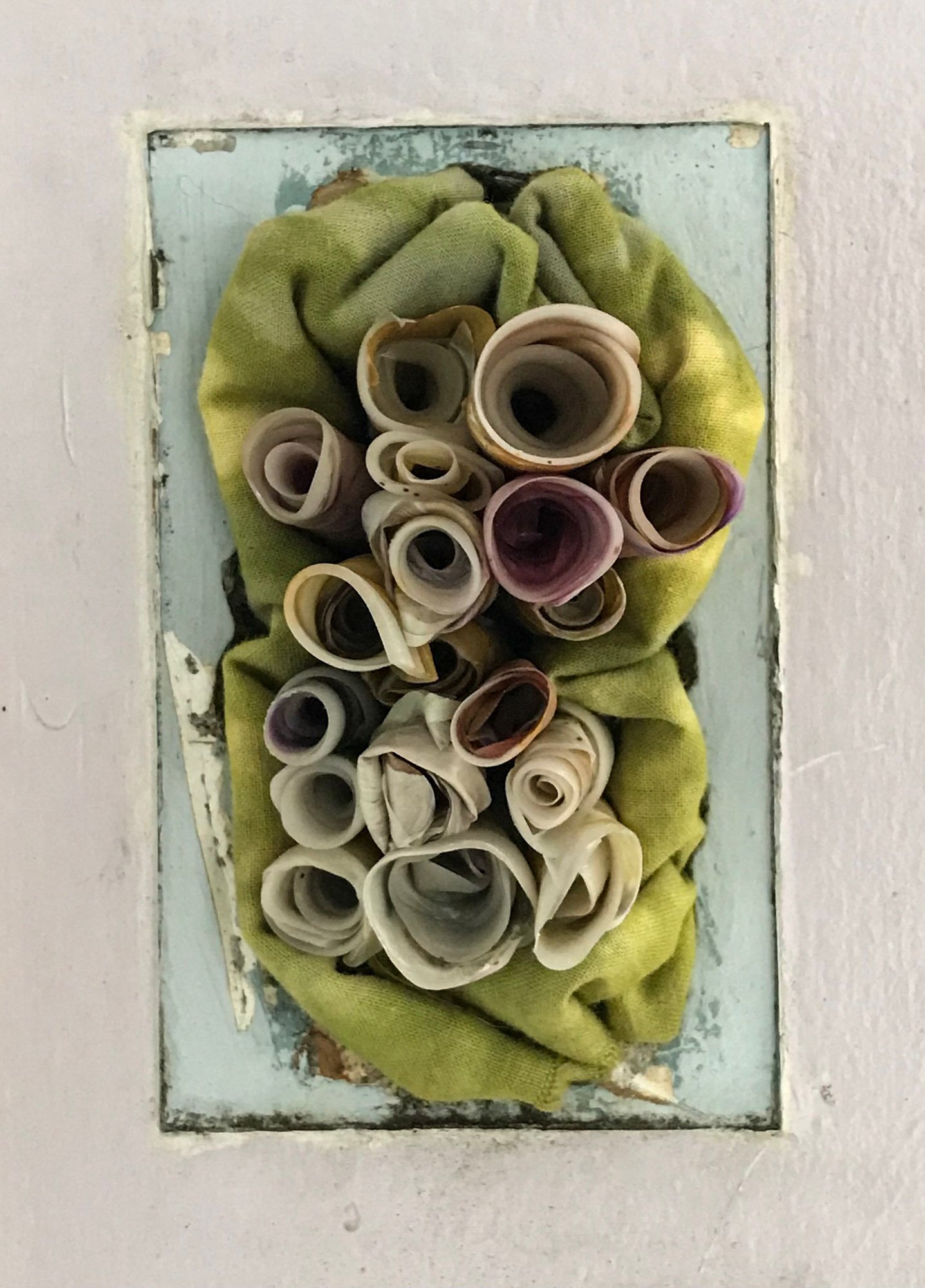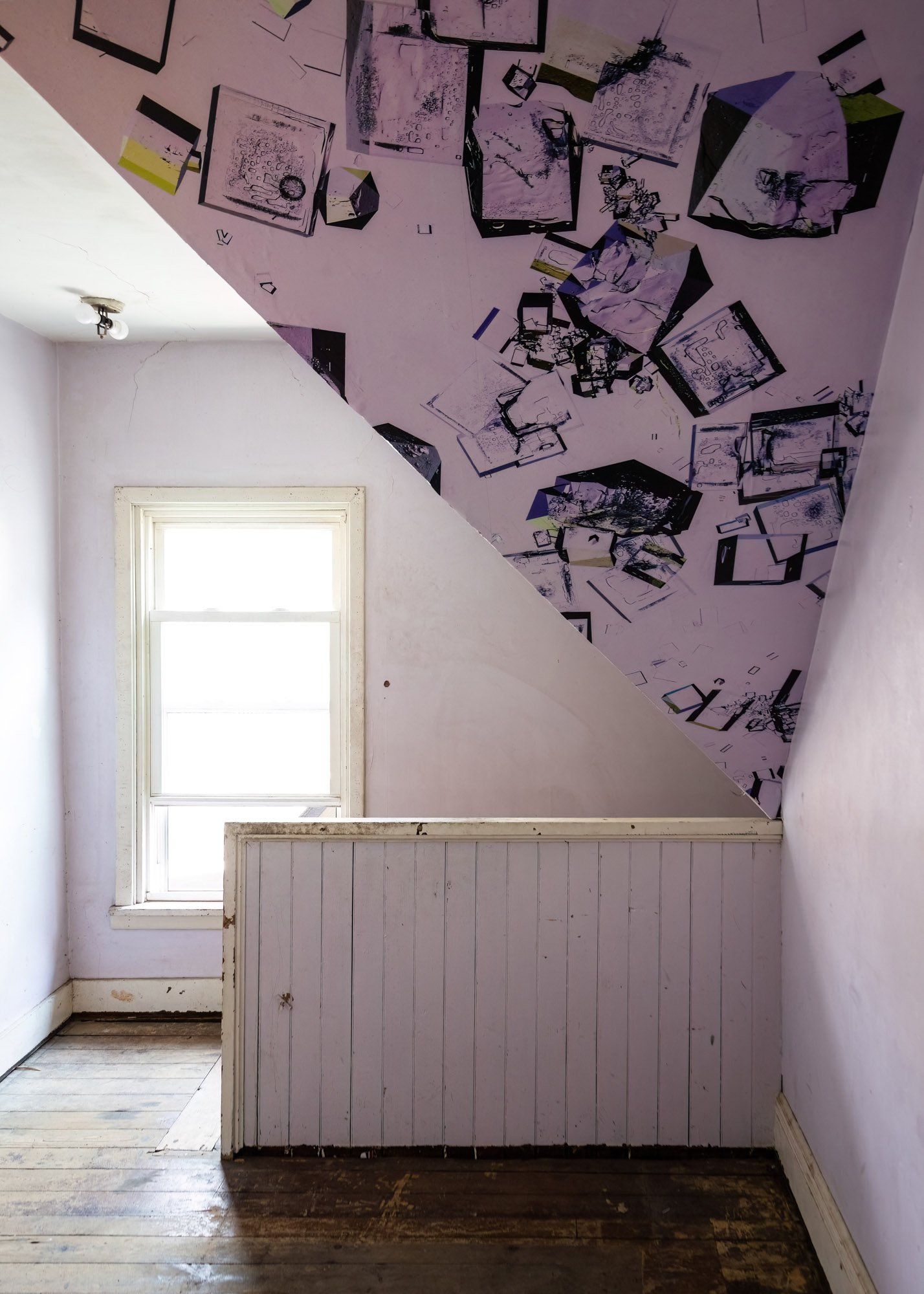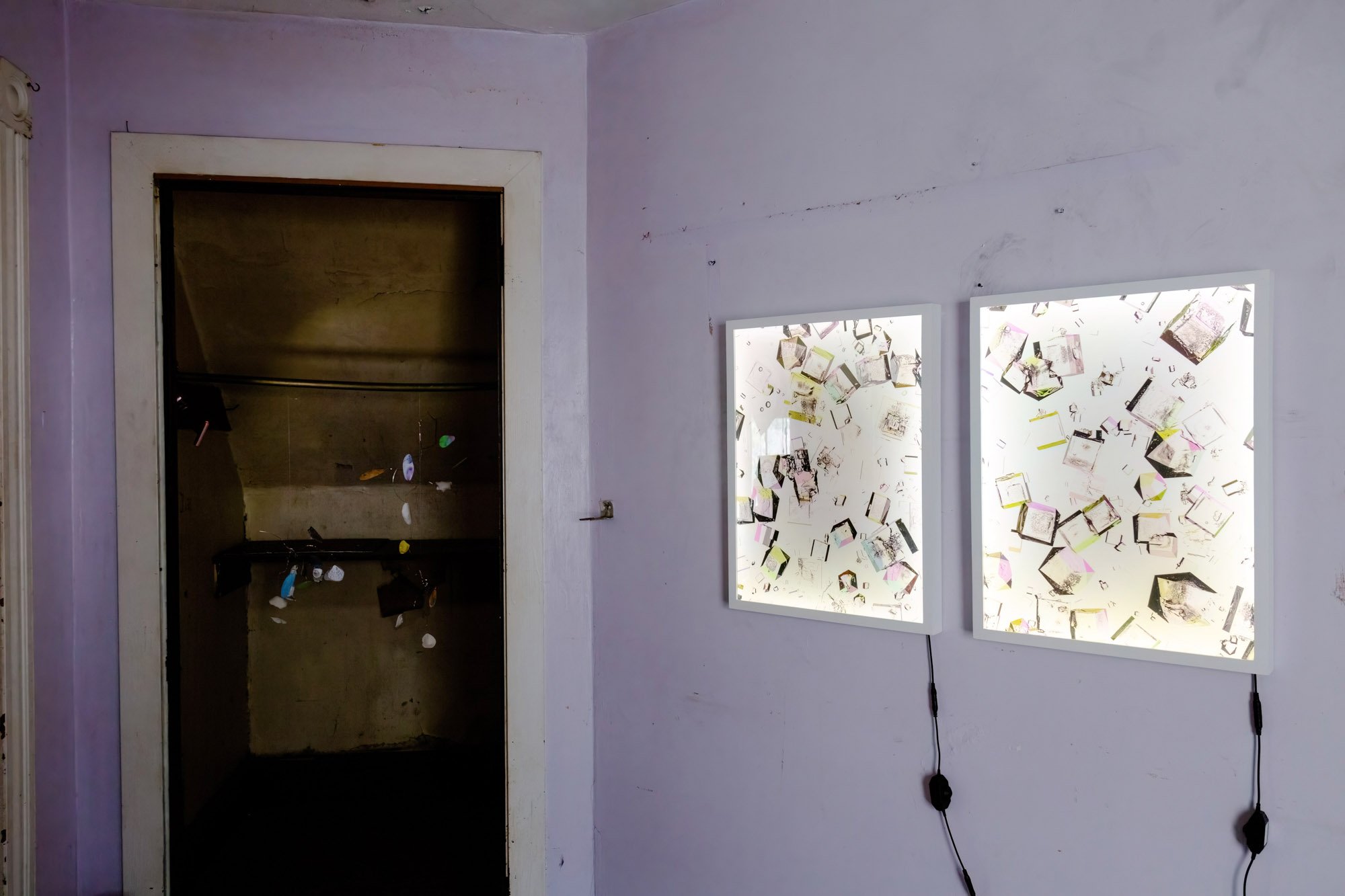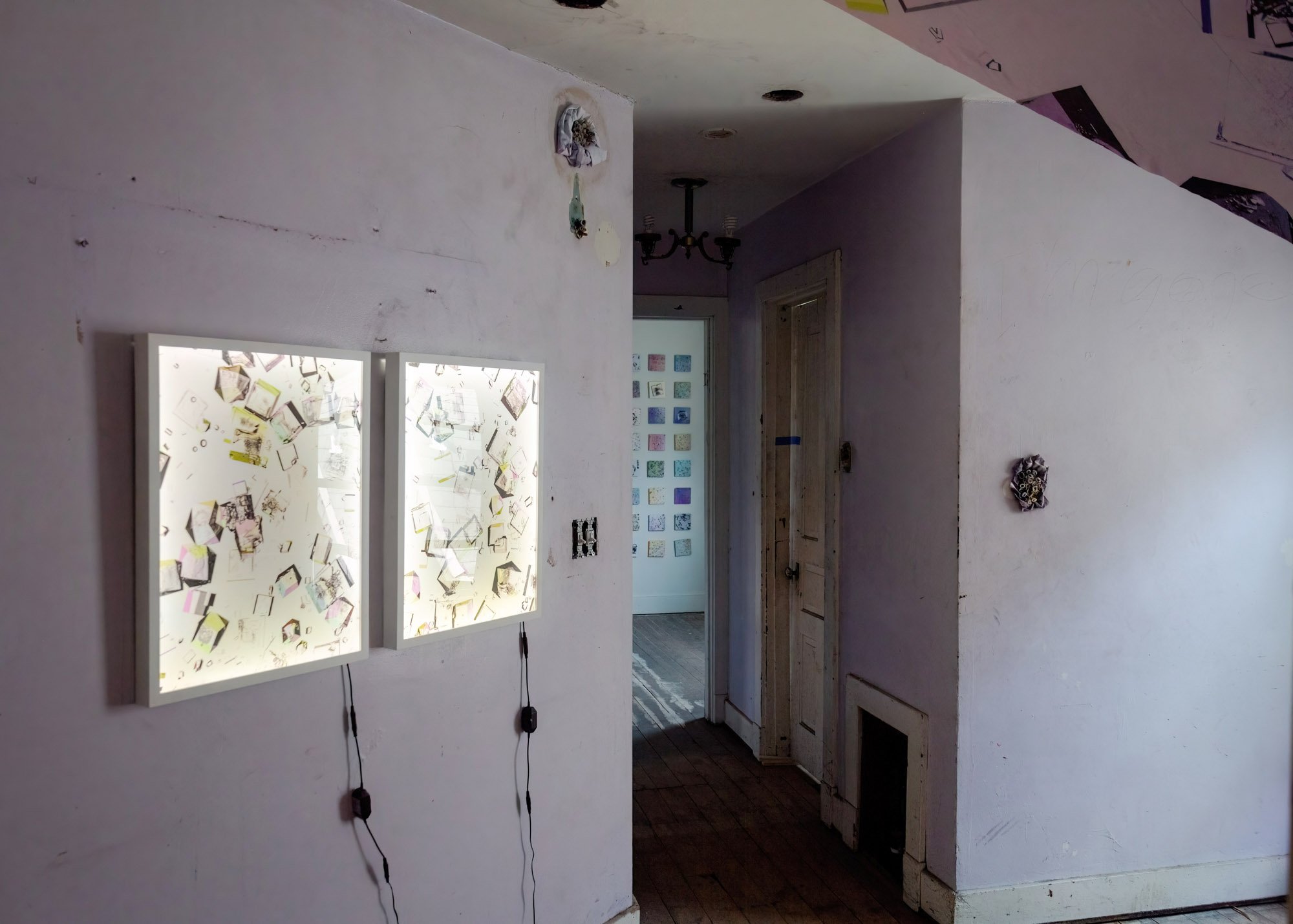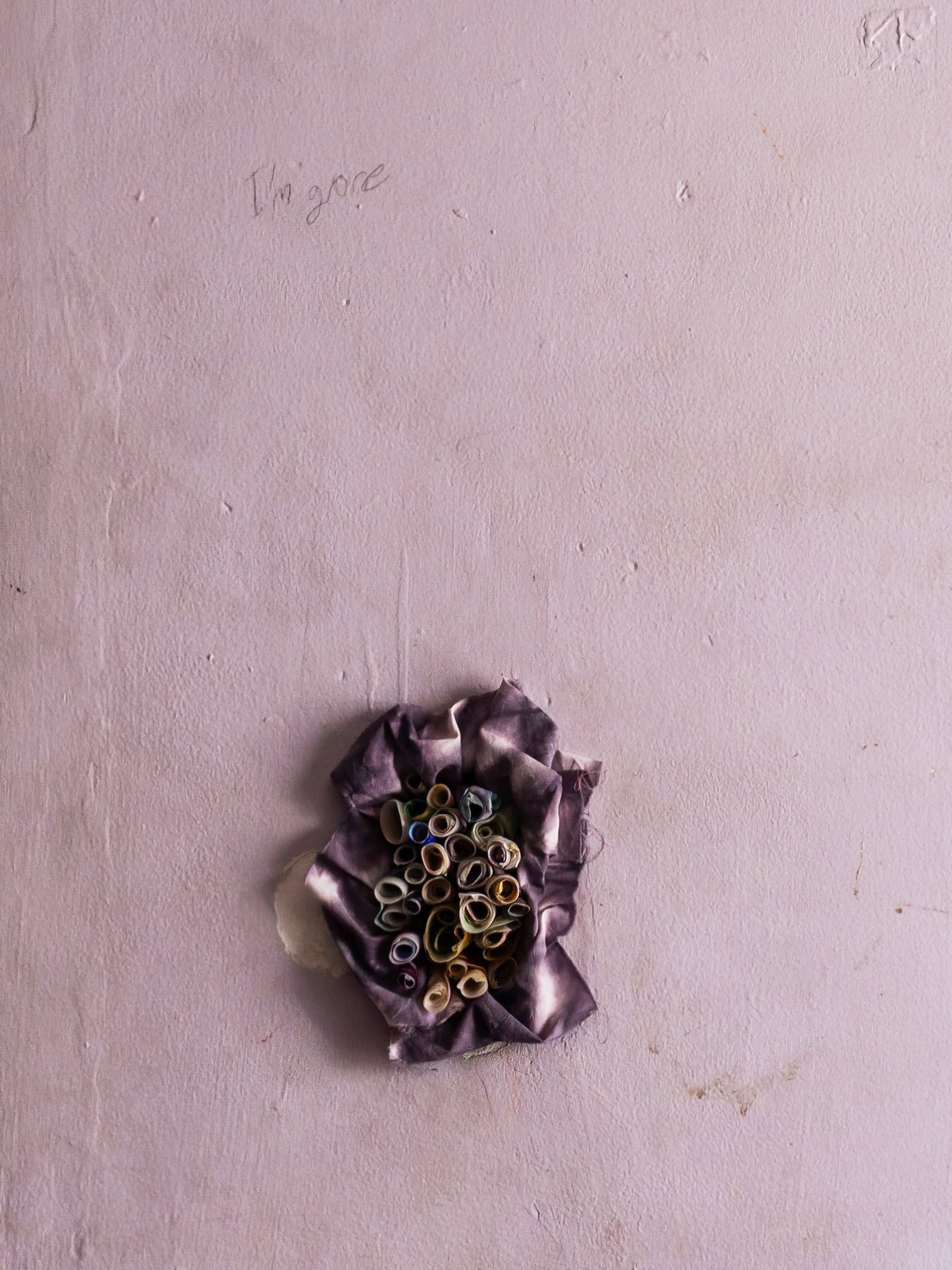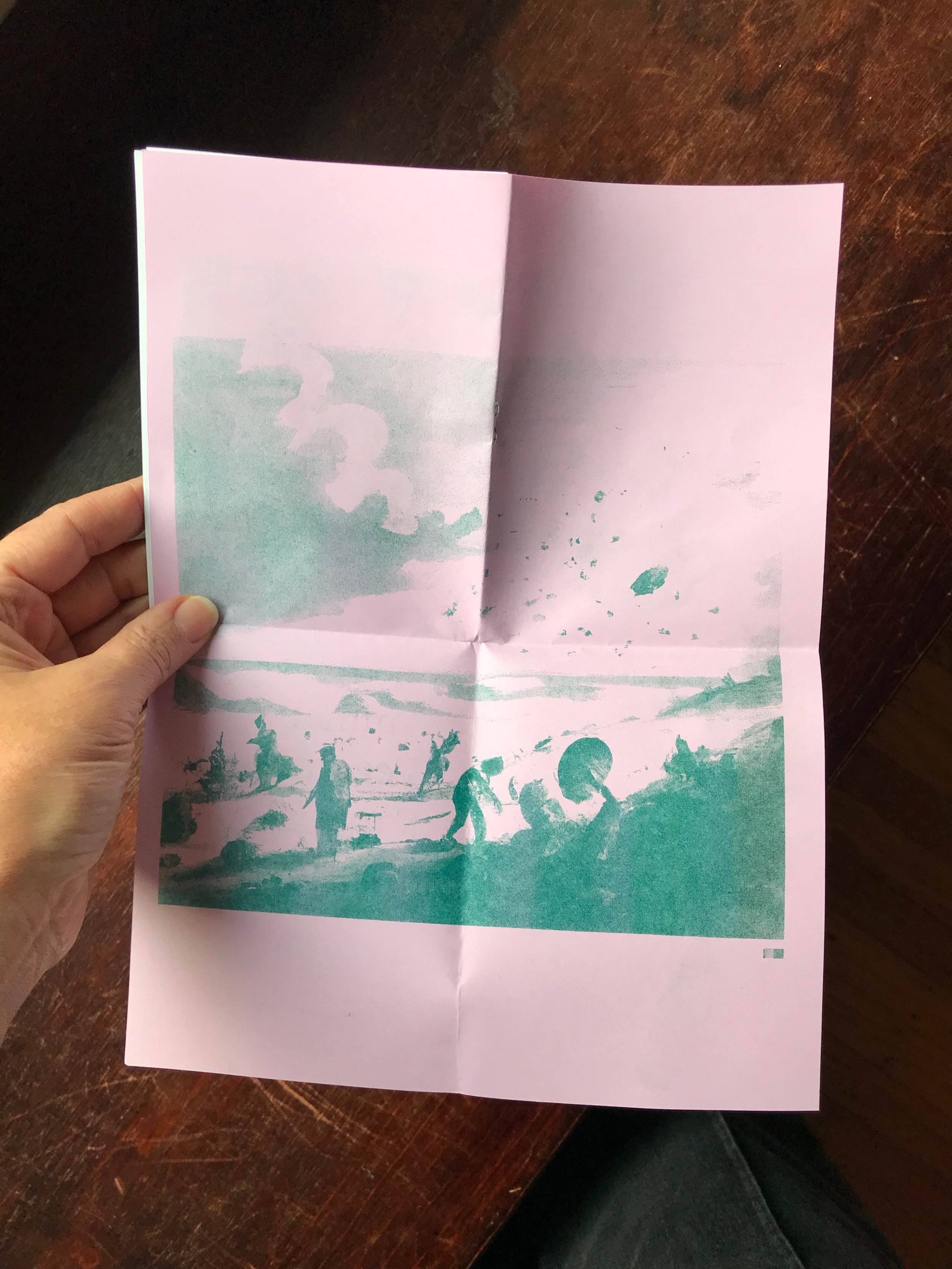Animal, Vegetable, Mineral, Other was a show about the imaginative life of domestic spaces, the creatures we share them with, and the materials that hold everything together. The show was open for two weekends in August at BlankSpace, an artist-owned mid-renovation house in Wilkinsburg.
Earlier this year, Travis Mitzel, Lauren Braun and I found ourselves in a conversation about how plastics figure into our respective art practices, which are very different from each other. Travis has produced a number of very compelling projects about animals. He and I had shared a table at a zine fair last year, where I was selling my little books and photos of salt crystals, and he had some literature about his Anti-Extinction Company. On the table with our wares was an adorable, robust, pink-gilled axolotl in a clear Sterilite tub. Travis raises axolotls, which it turns out are much more numerous in captivity than in the polluted wetlands of their native Mexico. He’d brought one along as a representative of the company, which operates by selling water from axolotl tanks as an organic plant food. The proceeds help subsidize the creatures in their human-facilitated urban habitat.
You’d be hard pressed to meet an artist who can bring more to the table than Travis when it comes to the rolling catastrophe of the Anthropocene, and its impact on all kinds of species. He has an ongoing project about goldfish, through which I learned about how these fish spend a substantial part of their lives in single-occupancy plastic bags, being shipped around the world in massive quantities through the global merchandise logistics system. They’re sold, won, or given away in those bags, and dispersed into homes one by one. Consumers often eventually release them into the wild, and over time they’ve naturalized in waterways just about everywhere humans can be found. In the right climate, they can live twenty years or more, easily outcompeting many native species.
We’re all so used to plastics being everywhere we look that it can be hard to notice them, even when we’re looking straight at them. I’ve been photographing single use plastics for years, switching back and forth with salt as a subject; they have a lot in common. This year I started moving forward with a new way of bringing them into the same images, using polarized light. In the photos I’ve been making this year, salt and plastics collaborate in refraction. It’s the plastics that bring color into the images, through the way they bend the polarized light, which is reflected by the surfaces of the salt crystals at different angles. The photos are eventually printed on a variety of plastic substrates: lenticular images, synthetic fabrics, vinyl murals, or specialized light-diffusing photo papers. Plastics carry the images, facilitate the images, constitute the images. Like they used to say on those old TV commercials: we’re soaking in it!
We installed the show in a house that bore many traces of the people who had lived there. In its current state of mid-renovation, the floors were dirty, there was no plumbing, there were holes where light fixtures might have been and in all kinds of other places. There was a lot of grime and dust, and also a lot of subtle, elegant flourishes, in places like mantels, door frames, and partially buffed walls where cracks revealed layers of color from decades ago. Those were the kinds of things that inspired Lauren Braun when she saw these rooms and hallways. Her collages feature accumulations of drawings about the size of the palm of your hand—drawings of different kinds of shells and rocks, architectural interpretations of flowers and leaves.
The house is small in terms of square footage, but everywhere you look it has little niches and corners, which became sites for surprising encounters with Lauren’s colorful mobiles. The gently floating petals of color in these pieces are organic shapes cut from painted Yupo, a synthetic material that takes ink much like watercolor paper.
Lauren also creates unique three-dimensional accumulations that at first look something like bundles of strange flowers, or clusters of mussels. Each of the little rolls in these bundles started out like a painting: different colors of acrylic paint are swirled together in little hand-sized pools. Later, she methodically peels each one off of its surface, and video recordings of this process have won her fans among people who find ASMR recordings soothing. Lauren installed several of these constructions, entitled “offerings to the house,” into holes and crevices in the walls.
As you proceed through the spaces, you end up at the end of a hallway where your perspective shifts a little. As you approach it you see one side of an angle, and as you get closer, you see another side of it, where the symmetrical wall is papered with a mural-sized print of crystals in a color scheme that extends the lavender of the walls. This faces down at a pair of lightboxes that feature a coordinated set of crystal images. On one side of these is a low closet where two mobiles are slowly turning. On the other side is a nested cluster of Lauren’s offerings. These are echoed, across the hallway, by another set, the last piece you see as you leave. On the wall where this is inset, there is a pencil inscription that you can barely see, but if the light is right, you can read it twice: I’m gone. I’m gone.
The show was cut short. I had to miss the first weekend, and among those who visited there were multiple COVID cases; meawhile, my whole family came down with COVID on the trip we were on that weekend. So when I got back, we had to cancel the reception. Lauren generously covered the gallery hours, so a few friends were able to attend that weekend. We did have a pretty cool print piece made as a gallery guide, with a nice Riso-printed cover thanks to Steve Grebinski and Misfeed Press. The illustration on the inside cover was generated by DALL-E2 using a prompt that came from one of the discussions that Lauren, Travis and I had early on: living in this time of impending climate catastrophe can feel like the moment of low tide before a tidal wave arrives, and we are like people wandering across the too-wide beach, collecting shells and strange treasures, trying for the moment to be as present as we can. (Email me your mailing address if you want one or a few of these, we had a lot of them left over.)
